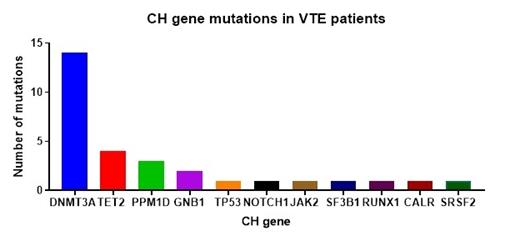Abstract
Background
Venous thromboembolism (VTE) is the third most common cardiovascular disease with an incidence over 1% in the elderly. About 50% of VTE is unprovoked, which is associated with higher rates of recurrent VTE and complications such as post-thrombotic syndrome. Clonal hematopoiesis (CH) refers to recurrent somatic mutations associated with hematologic malignancies that are present in otherwise healthy individuals. CH is more common with increased age, occurring in more than 10% of people over the age of 70 and has been associated with an increased risk of coronary artery disease. The rates of CH in patients with VTE or complications arising from this is not known.
Methods
Adult patients (age ≥ 18) with VTE were enrolled at the Ohio State University Thrombosis Clinic between 2017 and 2020. Clinical data was obtained at the time of routine clinic follow-up or ad hoc, and a research blood sample was collected with routine blood work. DNA extracted from peripheral blood mononuclear cells were analyzed for the presence of CH via error corrected next generation sequencing (NGS) using the Ion Gene Studio S5 System. A custom AmpliSeq panel IAH150087 was designed to detect CH, which included whole gene sequencing and hotspots in 25 common genes associated with myeloid malignancies, including DNMT3A, TET2, ASXL1, among others, with a sequencing depth of up to 50,000X. Data was collected and analyzed using Ion Torrent S5/GS-S5 Instrument with Torrent Suite 5.12.0 version. Final analysis of sequence data was performed using combination of software: Variant Caller v.5.12.10-1, IGV5.01 (0) and Ion Reporter v.5.12.3.0. The hg19 reference sequence was used to assess for deviation. CH was defined as a variable allele frequency ≥ 2%. Two sample t-test and chi-square test were used to compare patients with and without CH for continuous and categorical variables, respectively.
Results
A total of 167 patients are included the study. Median age is 60.3 years and 55% of patients are female. 80% of patients are white. The majority of patients have unprovoked VTE (81%); 23 patients (13.8%) have VTE associated with cancer. 84% of patients were treated with a direct oral anticoagulant. Over the median follow-up duration of 400 days, 7 patients had recurrent VTE and 19 patients had a total of 21 bleeding events (7 major bleeding and 14 clinically relevant non-major bleeding [CRNMB] by ISTH criteria).
Overall, 22 patients (13.2%) have detectable CH. Patients with CH are significantly older than those without CH (mean age 70 vs 59, p <0.0001). There is a trend towards increased CH rate in male patients (17% of male patients vs 10% of female patients with CH). There are no other differences in baseline characteristics among patients with and without CH, including type or location of VTE or cancer status. Among the 144 VTE patients without cancer, the median age is 60 years old and the CH rate is also 13.2%. In this group, the mean age of patients with CH is 12 years older than those without CH (70.5 years vs 58.4 years, p <0.0001). No other significant baseline characteristics are noted.
30 distinct CH mutations are noted in these 22 patients. Most patients have a single gene mutation (77%). Gene mutations in DNMT3A are the most common (46%), followed by TET2 (13%), and PPM1D (10%) (see figure). Most mutations are missense (57%), followed by nonsense (30%) and insertion/deletion mutations (13%). One patient has a JAK2 V617F mutation without known history of myeloproliferative disease. 8 CH patients with serial samples collected over a median duration of 136 days (range 91 - 490 days) showed no significant change in CH clone size over time.
Patients with CH have no differences in rates of recurrent VTE or arterial thrombosis compared to those without CH. Patients with CH have a trend towards increased rate of combined major bleeding and CRNMB events (23% vs 10%, p=0.14). Patients with CH also had a trend towards increased mean corpuscular volume (MCV) (mean 93.5 vs 90.7, p=0.13), although no other cytopenias or differences in complete blood count parameters were noted.
Conclusion
The CH rate in patients with VTE was not found to be much higher than what might be expected by age alone. We found no change in the CH rate after excluding cancer patients. A larger VTE population with age-matched controls will better determine the CH rate in patients with VTE. CH can be a consideration in designing future clinical VTE studies that assess bleeding risk.
Byrd: Vincerx Pharmaceuticals: Current equity holder in publicly-traded company, Membership on an entity's Board of Directors or advisory committees; Newave: Membership on an entity's Board of Directors or advisory committees; Novartis, Trillium, Astellas, AstraZeneca, Pharmacyclics, Syndax: Consultancy, Honoraria. Wang: Servier: Membership on an entity's Board of Directors or advisory committees; Leo Pharma: Research Funding.


This feature is available to Subscribers Only
Sign In or Create an Account Close Modal